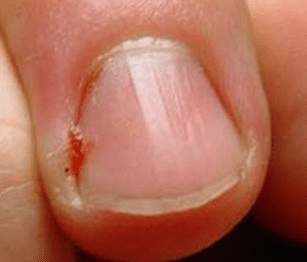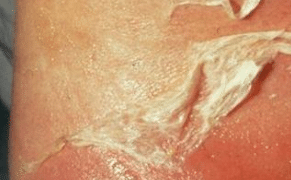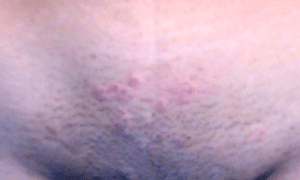A hangnail can be described as a small piece of torn skin that forms on the very edge of your fingernail. An infection to the jagged skin on your finger is very common and it can be treated easily. There are numerous things that can cause your fingernail to develop a hang nail ranging from cuts or injury to skin irritation. An infection may occur on the hangnail when bacteria or fungi get through the broken skin to the inner tissues of the skin. The infection that occurs between the nail and the skin is usually known as paronychia.
What do Hangnails Mean?
When you experience some pain around your fingernails, this may be a sign of irritation or an infection. In most cases, when this occur with swelling and redness around your fingernail it may be due to an infected hangnail. Some sources explain a hangnail as a piece of peeled skin near the tip corner of the nail that appears as jagged or torn. In most cases, the condition affects the fingernails but may as well form on your toenails.
A hangnail is very different from an infected or ingrown nail. A hangnail is a condition that only refers to the skin along the sides of the nail, and not the nail itself. Hangnails are very common to people who have dry skin that may peel off very easily, especially those in winter or after being exposed to warm water for a prolonged period of time. The infection on the hangnail usually takes place after the area is exposed either to bacteria or fungus.
An infected hangnail should be treated as fast as possible to prevent severe conditions. In most cases, the condition can easily be treated at home by the use of home remedies. If it has not cleared after a series of home treatment, you should consult your medical provider.
What are the symptoms for infected hangnail?
Hangnail usually appears on the finger nails and in some cases may occur on the toenails as well. The condition may occur with different symptoms depending with the type of infection that has taken center stage. The following are some of the common symptoms that may be associated with an infected hangnail:
- Swelling and tenderness
- Sharp shooting pain and burning sensation
- A warm feeling
- A pus –filled abscess as the edge of the affected nail
- Bleeding in some cases
When the infection is caused by bacteria, the symptoms may occur immediately while for fungi, the symptoms may take longer before they appear.
What Causes Infected Hangnail?
A number of micro-organisms are responsible for occurrence of an infected hangnail. Apart from that, there are numerous conditions that may make some people to easily develop hangnails. All of these, we are going to discuss below.
- Dry skin
Dry skin is very common especially to people who are experiencing winter. This is usually seen by a peeling skin around the nail bed. The moisture content of air during the winter time is lower as compared to the summer months. This therefore promotes dryness of the skin thereby causing skin peeling around the finger nails.
Moreover, there are some people that generally have dry skin that peels off very easily. These are the kind of people that are frequently seen with hangnails.
It is with the same reason that your skin usually feels much drier during this season. The air in the arid area dries out the skin around the fingernails and causes hangnails to form. After the hangnail has formed, germs may then penetrate through the peeled skin to cause an infection.
- Nail biting
Nail biting also is a vise that predisposes one to start to develop a peeling skin around the nail bed. If you are a person who likes biting nails instead of using the right procedure to cut your nails short, you run the risk of tearing off some part of the skin that surrounds your nail bed thereby causing hang nails. This is because the tearing may damage the skin under the nails therefore resulting into more hangnails that are easily exposed to infections from either bacteria or fungus.
- Prolonged exposure to water
Also, it has been noted that if you expose your hands to water for a long period of time, you may develop hangnails. This is because if the fingernails stay in water for long, they become so soft and therefore can be peeled very easily very little force. In some cases, when the nail bed is exposed to water for long period of time, it start causing separation from the skin and therefore exposing the inner tissues to germs infection. Therefore, you can wear protective gear if you are going to be exposed to water for a long period of time.
Additionally, water that contains chlorine has been noted to be the worst when it comes to skin dryness as it accelerate the rate at which hangnails are forming on your fingernails.
- Exposure to harsh chemicals
Some chemicals can cause irritation to the skin thereby resulting to peeling. Others may cause skin dryness which also is a reason for peeling around the nails thereby causing hangnails. There are several ingredients in some chemicals we use every day such as detergents, nail polishes and cosmetics that can dry the skin around the nails thereby resulting in hangnails. If you have been using a certain substance and realized that there is some skin peeling around your nail bed, stop using it for some time to avoid making the situation worse.
- Injury or trauma
There are many cases that you may accidentally cause an injury to areas around your nail bed. For example, you may hit your nail while riveting or in a workshop. Also, you can easily cause an injury to your nail bed while cutting some spices while you cook. In that case, you be advised to always wear protective gear if you carry activities that may pose anger to your finger nails. Some injuries to the nail bed may occur as white you are trimming your fingernails. Always use the right procedure while doing this.
So, hangnails on their own are not infected until certain micro-organisms such as bacteria or fungus has penetrated through the open skin to the inner tissues where they cause infection, thus infected hangnail. Therefore, in a nutshell, some of the most common causes of hangnails are as follows:
- Dry skin which is usually caused less moisture in air during winter months and then cause skin peeling easily.
- Nail biting behavior
- Increased exposure to harsh chemicals found in substances such as detergents, nail paint removers, hand sanitizers and dish washers.
- Poor nail cutting or nail clipping procedures that causes excessive cutting of cuticles.
- Injury or trauma to the nail bed
- Swimming in pools that contain chlorine water that result in skin dryness and accelerate the formation of hangnails.
How do you treat an Infected Hangnail?
An infected hangnail can be extremely annoying and painful in most cases, and therefore treatment may be needed to deal with such symptoms. This is usually something you may experience frequently and it is rarely discussed around the water cooler, but it is a common condition for both men and women. The treatment that is done on the infected hangnail is usually different to the treatment carried out on a hangnail that is not infected.
Treatment for infected hangnail
If your hangnail is infected and associated with a lot of symptoms as we discussed above, you will have to visit your medical provider for diagnosis to establish which kind of micro-organisms are causing the infection. After the cause of the infection is established, treatment will be administered ranging from antifungal creams in cases of fungus, and antibiotics in the cases of bacterial infection. Also, pain killers may be used in case of a lot of pain. You may follow the following steps while you treat the hangnails:
- Warm water soak – soak the affected nail in warm water for 15 to 20 minutes up to 4 times in a day. This will help to increase the flow of blood and therefore facilitate removal of germs from the area
- Moisturize – The area around the infected hangnail should be well moisturized. You may use hand lotion and hand creams to facilitate moistening your hands. When the hangnail is soft due to soaking, trim the edges to prevent more hangnails from catching to anything, and to reduce the risk of more infection.
- Trim the hangnail – Avoid biting and picking the nails. Use the right procedure to trim your hand nails regularly.
- Avoid causing damage to the skin around your nails. The area should always remain smooth.
- Medical creams – applying small amounts of antibiotics or antifungal creams depending on the cause of the infection may help to heal the infected hangnail or stop the infection from spreading. This should be done in line with prescription from a medical practitioner or chemist.
In case the infected hangnail has developed an abscess or starts to produce pus, you may need to drain out the pus so that the infection is stopped from spreading. Also, this is a procedure that should be carried by someone who is trained. To drain an abscess on that has developed from an infected hangnail, the following procedure is followed:
- Numb the area
- Then lift the nail fold by use of an instrument to allow the pus to drain away. Here, a surgical incision is rarely necessary but if needed, do it.
- Make sure all the pus has been drained and then wash the area thoroughly
- Place a gauze strip on the wound. Let it stay at most for 48 hours so that it prevent more germs into the wound
- You may take an oral antibiotic medication.
Home remedies for infected hangnails
- Stop biting your hangnails
It has been noted that nail biting contributes to hangnails as well as increases the risk of developing an infection or warts. Additionally, you can transfer viruses and bacteria that are on your finger directly in the mouth, thereby leading to illnesses such as colds and flu. Hangnail bites may cause deep cuts, which are more painful as compared to the original hangnails. Therefore, one of the best natural treatments to get rid of hangnails is by stopping the nail biting habit.
- Moisturize regularly
Keep your hands moisturized regularly especially during the winter periods. This may as well help to reduce occurrence of hangnails as dry skin promotes skin peeling around the nail bed which in turn result in hangnails. Therefore, if you are prone to hangnails, try to apply lotion or hand cream to your nail beds at least 2 to 3 times in a day. This is an easy step by may have a big impact when it comes to dealing with hangnails.
- A simple soak
Soak the affected nail in warm water that contains some salt for about 10 to 15 minutes, as this will help the pus to drain and make the pain to reduce. Once the infected nail is soaked in water, it will make it much easier and less painful to clip the hangnail so that you can cut it. It is very important to clip the hangnail when it is soft than when it is hard, as clipping a hard hangnail can result in bleeding and a burning sensation.
- Hydrogen peroxide
You may as well wash the infected hangnail with hydrogen peroxide to speed up the healing process. You may add some hydrogen peroxide into some water so that it is enough for you to soak in your finger for around 20 minutes. Hydrogen peroxide helps to kill germs and clean the wound effectively. Afterwards, you may take warm olive oil or coconut oil and massage it carefully on the affected nail bed and fingers.
- Almond mask and garlic mask
Make a fine paste from almond by grinding it. You may as well involve almond oil to the paste in order to dilute it. Further, add egg yolk in it and blend properly to get a fine and smooth paste. Apply the paste on the affected area of the hangnail.
When using garlic as an antibacterial and anti-inflammatory agent, it may help to treat infection, swelling and provide relief. Grind the garlic gloves and put them over an around the infected hangnail for better results.
Infected Hangnail Pain Relief
In case you want to relieve pain from an infected hangnail, you may follow the following procedures:
- Apply a wrapped ice in a plastic bag on the affected area, as this will help in reducing pain and swelling effectively
- Hangnails can be caused by exposure to soap and water, chemicals or cleansers for long periods; therefore you can wear gloves while using such chemical to avoid such conditions.
- Oil extracts such as tea tree oil, lavender oil, wheat germ oil, sesame oil and olive oil can help to cure the infected hangnail and reduce pain drastically. Massage any of these oils on the affected area at least twice in a day for 15 minutes.
- Apply turmeric on the affected area and cover with a cotton since it is an antiseptic agent that will help to fight the pain.
- Apply a honey paste and cinnamon powder on the affected area and wash off after an hour. The end by a massage on the affected area by the above oils.
Ingrown Hangnail Causes
When the ridges of your nails correspond to skin ridges underneath your nails, they help to hold your nail in place. When a hangnail is not removed, it may grow under the nail thus resulting into an ingrown hangnail. The shape of your nail changes, the ridges that holds your nail in place can lose their connection. This can cause the hang nail to grow into the sides or corners of the nail bed. Usually, this is usually referred to as ingrown hangnail. Some of the conditions that may cause this condition include:
- Injury
- Fungal infection
- Growth that is too fast or too slow
- Improper trimming of the nail, such as leaving a nail spike on the end
- Nail biting.
More references
- How to treat an infected hangnail: https://www.medicalnewstoday.com/articles/320933.php
- Hangnail infection: https://gudhealth.com/hangnail-infection.html
- How to recognize and treat an infected hangnail: https://www.healthline.com/health/infected-hangnail
- Hangnails symptoms, causes and treatment: https://www.drkoop.com/hangnails-symptoms-causes-treatment/
- Home remedies to cure pain and hangnail infections: http://www.sweetadditions.net/beauty/home-remedies-to-cure-pain-of-hangnail-infection










